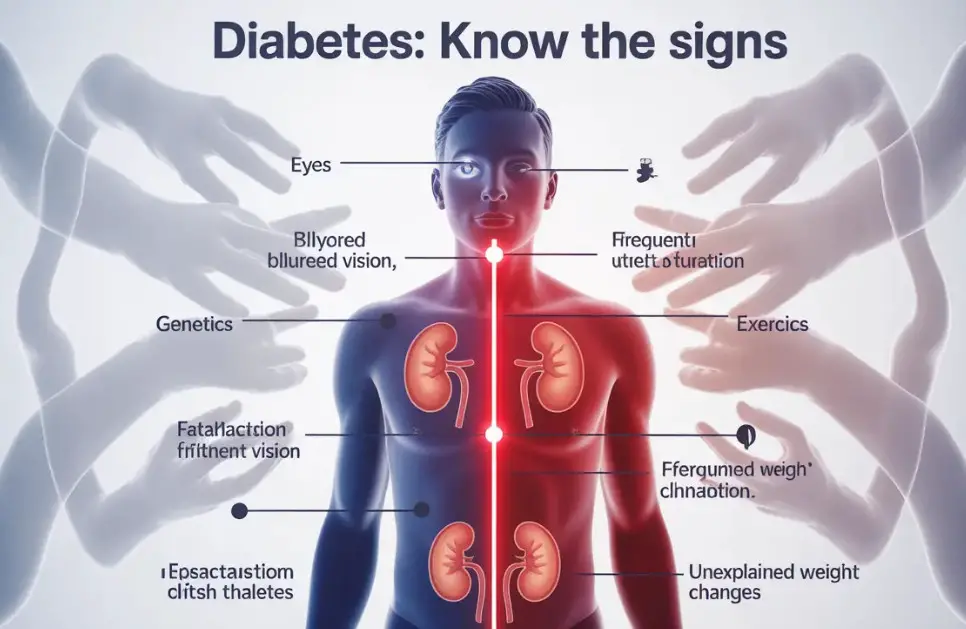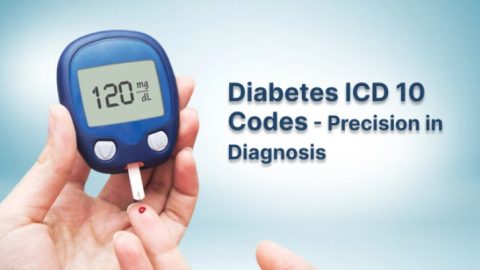Diabetes is one of the most common chronic health conditions worldwide, affecting millions of people each year. Many individuals live with diabetes without realizing it, since the symptoms may appear gradually or be mistaken for other health issues. Early detection is crucial because untreated diabetes can lead to serious complications, including heart disease, kidney damage, and nerve problems. Recognizing the warning signs and learning simple ways to check at home can help you take control of your health.
This guide explains how to know if you might have diabetes, what symptoms to look for, and what simple methods you can use at home to monitor your health. While home checks cannot replace professional diagnosis, they provide valuable insight and encourage you to seek medical advice promptly.
Understanding Diabetes

What Is Diabetes?
Diabetes is a condition that occurs when the body cannot properly regulate blood sugar (glucose) levels. Normally, insulin, a hormone produced by the pancreas, helps glucose enter cells to provide energy. In diabetes, either the body does not make enough insulin, or the cells become resistant to it, causing high blood sugar levels.
There are three main types of diabetes: type 1, type 2, and gestational diabetes. Type 1 usually develops early in life and requires lifelong insulin therapy. Type 2, the most common type, often develops gradually and is strongly linked to lifestyle and genetics. Gestational diabetes appears during pregnancy but can increase the risk of type 2 diabetes later.
Understanding these types is important because the signs and methods of detection can differ slightly. However, all forms of diabetes share some common symptoms and require monitoring of blood sugar.
Why Early Detection Matters
Catching diabetes early allows you to take steps that prevent complications. High blood sugar, if left unchecked, damages blood vessels, nerves, and organs. Conditions such as vision loss, kidney disease, and heart attacks are common complications of uncontrolled diabetes.
By learning how to recognize the warning signs and monitoring your blood sugar at home, you give yourself the opportunity to make lifestyle changes, seek medical advice, and manage the condition effectively.
Common Symptoms of Diabetes
Frequent Urination and Excessive Thirst
One of the earliest and most noticeable signs of diabetes is the need to urinate frequently. This happens because excess sugar in the blood pulls fluid from tissues, forcing your kidneys to work harder. As a result, you may feel constantly thirsty, no matter how much water you drink.
If you notice yourself waking up multiple times during the night to urinate, or you cannot quench your thirst, it could be an indicator of high blood sugar.
Unexplained Weight Loss or Gain
Sudden changes in weight without a change in diet or exercise can also signal diabetes. In type 1 diabetes, the body may break down muscle and fat for energy because it cannot use glucose effectively, leading to weight loss. In type 2 diabetes, many people experience weight gain due to insulin resistance.
Monitoring changes in your body weight over time can provide useful clues. If you experience unexplained shifts, consider checking your blood sugar.
Constant Fatigue
When cells cannot absorb glucose properly, your body lacks energy, leaving you feeling tired even after resting. Persistent fatigue that does not improve with sleep or relaxation is a common symptom of diabetes.
This fatigue often affects concentration, mood, and productivity, making daily activities more challenging.
Blurred Vision
High blood sugar can cause swelling in the lenses of your eyes, leading to blurred or distorted vision. While this may improve once blood sugar levels stabilize, untreated diabetes can eventually cause permanent eye damage.
If you suddenly experience blurry vision or difficulty focusing, especially when combined with other symptoms, it may be a warning sign.
Slow-Healing Wounds and Frequent Infections
Diabetes weakens the immune system and slows down circulation, which affects the body’s ability to heal. Small cuts, bruises, or infections may take longer to recover than usual.
Pay attention to recurring skin infections, gum problems, or yeast infections, as these can also indicate elevated blood sugar levels.
How to Check for Diabetes at Home
Monitoring Symptoms
The very first step in checking for diabetes at home does not require any tools—it starts with paying close attention to your body. Diabetes often develops gradually, which means the signs can be subtle at first. You may notice yourself drinking water more frequently, waking up at night to urinate, or feeling tired even after a full night’s rest. These may seem like small inconveniences, but when they occur together and persist, they are strong indicators of elevated blood sugar.
One of the most practical ways to track these changes is to keep a simple health journal. Write down daily notes about how many times you urinate, whether you feel thirsty often, and how your energy levels fluctuate throughout the day. Including information about your diet, sleep, and physical activity can also help identify patterns. Over time, this record becomes a valuable reference that shows whether the symptoms are temporary—such as from dehydration—or persistent, which may suggest diabetes.
By monitoring your symptoms consistently, you can catch early warning signs before they worsen. If you notice a combination of excessive thirst, unexplained fatigue, blurred vision, and slow-healing wounds, it is a strong signal to take the next step: measuring your blood sugar directly.
Using a Glucometer
A glucometer is one of the most reliable and accessible ways to check for diabetes at home. This small handheld device measures blood sugar levels using just a drop of blood, usually obtained from your fingertip. It is widely available at pharmacies, affordable, and easy to use—even for beginners.
To test your blood sugar, you prick your finger with a sterile lancet, collect a tiny drop of blood, and place it on a disposable test strip. The strip is then inserted into the glucometer, which displays your blood glucose reading within seconds. For the most accurate results, it is best to check your blood sugar both in the morning before eating (fasting glucose) and two hours after meals.
According to medical guidelines, a normal fasting blood sugar level should range from 70 to 99 mg/dL. Readings between 100 and 125 mg/dL suggest prediabetes, while results of 126 mg/dL or higher on more than one occasion may indicate diabetes. Similarly, post-meal readings above 200 mg/dL are concerning and should not be ignored. While a glucometer cannot provide a definitive diagnosis, repeated abnormal readings are a clear reason to consult a healthcare professional for further testing.
Home A1C Test Kits
For a broader picture of your blood sugar control, at-home A1C test kits are another option. Unlike a glucometer, which measures glucose at a single point in time, the A1C test provides an average of your blood sugar levels over the past two to three months. This makes it particularly useful for identifying long-term patterns and detecting prediabetes or diabetes that may not show up in occasional daily readings.
These kits are easy to use: most require a small finger-prick blood sample that is either processed instantly with a digital device or mailed to a laboratory for analysis. The results are expressed as a percentage, which corresponds to average blood sugar levels. An A1C level below 5.7% is considered normal. A range of 5.7% to 6.4% suggests prediabetes, and a result of 6.5% or higher is typically diagnostic for diabetes.
While convenient, it is important to remember that home A1C kits are not a substitute for professional testing. Factors such as anemia, certain medications, or inaccurate sample collection can affect results. If your A1C results fall into the prediabetic or diabetic range, scheduling a medical appointment is the next essential step.
Checking with Urine Glucose Strips
Urine glucose strips offer another simple way to check for possible diabetes at home, although they are less precise than blood-based tests. These strips work by detecting glucose in your urine. Normally, glucose should not appear in urine because the kidneys filter it out and return it to the bloodstream. However, when blood sugar levels become very high, the kidneys are unable to reabsorb all the glucose, and it spills into the urine.
To use them, you dip the strip into a urine sample and wait for the color to change. The strip’s packaging usually includes a color chart to help interpret the results. If glucose is detected, it is a sign that your blood sugar is likely higher than normal. However, urine strips cannot measure exact blood sugar levels and may miss early stages of diabetes or prediabetes. They also do not account for fluctuations that occur throughout the day.
Because of these limitations, urine test strips should only be seen as an initial screening tool. If glucose is found in your urine, it is an important signal to follow up with more accurate testing methods like a glucometer or an A1C test, and ultimately with professional medical evaluation.
Risk Factors to Consider
Family History and Genetics
Genetics play a significant role in the development of diabetes, especially type 2 diabetes. If you have parents, siblings, or close relatives with the condition, your own risk automatically increases. This is because inherited genes can influence how your body produces and uses insulin, making you more prone to insulin resistance. In type 1 diabetes, genetics can also be a factor, though the exact causes involve a combination of genes and environmental triggers.
Keeping track of your family’s medical history is an important step in assessing personal risk. If multiple members of your family have been diagnosed with diabetes, it is wise to be extra cautious about your lifestyle choices. Regular health check-ups, early screenings, and home monitoring can help detect warning signs before they become serious health problems.
While you cannot change your genetic background, being aware of it empowers you to take proactive measures. Healthy eating, staying active, and maintaining a proper weight can offset many of the risks that come
Lifestyle Habits
Daily habits have a powerful impact on whether or not you develop diabetes, particularly type 2 diabetes. Diets high in refined carbohydrates, sugary drinks, and processed foods place extra stress on the body’s insulin response, eventually leading to insulin resistance. A sedentary lifestyle compounds this risk, as physical activity is one of the body’s best defenses against rising blood sugar.
Smoking and excessive alcohol consumption are additional risk factors. Nicotine interferes with insulin sensitivity, while alcohol adds extra calories and may affect the liver’s ability to regulate glucose properly. Together, these habits create the perfect environment for high blood sugar and metabolic imbalance.
The good news is that lifestyle habits are within your control. Making small but consistent improvements—such as swapping processed snacks for whole foods, walking daily, or cutting back on sugary beverages—can significantly reduce your risk. Even modest changes in diet and exercise have been shown to improve insulin sensitivity and lower the likelihood of developing diabetes.
Age and Other Conditions
Age is another important factor to consider when evaluating diabetes risk. The likelihood of developing type 2 diabetes increases steadily after the age of 45, partly due to natural changes in metabolism, reduced muscle mass, and decreased physical activity levels. As the body becomes less efficient at processing glucose, blood sugar levels tend to rise with age.
Other health conditions also raise the risk of diabetes. High blood pressure and high cholesterol, for example, strain the cardiovascular system and often occur alongside insulin resistance, forming what is known as metabolic syndrome. Obesity is one of the strongest risk factors, since excess body fat—especially around the abdomen—directly contributes to insulin resistance.
Women who have experienced gestational diabetes during pregnancy face a significantly higher risk of developing type 2 diabetes later in life. Similarly, conditions such as polycystic ovary syndrome (PCOS) are linked to impaired insulin function. If you fall into these categories, regular blood sugar monitoring and proactive lifestyle management become even more important to maintain long-term health.
When to Seek Professional Help
Signs You Should Not Ignore
If your home tests show consistently high blood sugar levels, or you experience multiple symptoms such as extreme thirst, blurred vision, and unexplained fatigue, it is important to contact a healthcare provider.
Even if your symptoms seem mild, early professional evaluation ensures timely treatment and prevents complications.
What to Expect from a Doctor’s Visit
During a medical check, your doctor may order blood tests such as fasting plasma glucose, oral glucose tolerance test, or A1C. These tests confirm whether you have diabetes or prediabetes.
Your healthcare provider may also check for related conditions, such as high blood pressure, high cholesterol, or organ damage, to create a full treatment plan.
Lifestyle Tips for Managing Blood Sugar
Eating a Balanced Diet
Choosing whole foods, fiber-rich vegetables, lean proteins, and healthy fats helps regulate blood sugar. Avoiding processed sugars and refined carbohydrates is equally important. Meal planning and portion control can prevent spikes in blood glucose.
Staying Physically Active
Regular exercise increases insulin sensitivity, allowing your body to use glucose more effectively. Aim for at least 30 minutes of moderate activity, such as walking or cycling, five times a week.
Maintaining a Healthy Weight
Losing even a small percentage of body weight can significantly reduce the risk of developing type 2 diabetes. Combining diet and exercise is the most effective way to achieve and maintain a healthy weight.
Stress and Sleep Management
Stress hormones raise blood sugar levels, so practicing relaxation techniques such as deep breathing, meditation, or yoga is beneficial. Adequate sleep is equally important, as poor sleep disrupts insulin regulation.
Myths About Diabetes You Should Know
Myth: Only Overweight People Get Diabetes
While being overweight increases the risk, many thin individuals also develop diabetes due to genetics, age, or other health conditions.
Myth: Eating Sugar Directly Causes Diabetes
Consuming sugar alone does not cause diabetes, but a poor diet high in sugar and processed foods can lead to obesity and insulin resistance, which contribute to type 2 diabetes.
Myth: Diabetes Cannot Be Controlled Without Medication
Lifestyle changes often play a major role in controlling diabetes. In some cases, diet and exercise alone can help maintain healthy blood sugar levels, especially in prediabetes and early type 2 diabetes.
FAQs About Diabetes Detection at Home
Can I fully diagnose diabetes at home?
No. Home methods can indicate possible diabetes, but only a healthcare provider can confirm a diagnosis through professional tests.
How often should I check my blood sugar if I suspect diabetes?
If you have symptoms, check your blood sugar at least once daily at different times, such as fasting and after meals. Record results and share them with your doctor.
What should I do if my home test shows high blood sugar?
Repeat the test at a different time to confirm. If the results remain high, contact your healthcare provider as soon as possible.
Can lifestyle changes reverse diabetes?
Prediabetes and early type 2 diabetes can often be managed and sometimes reversed with lifestyle changes. Type 1 diabetes, however, requires insulin treatment.
Conclusion
Knowing how to recognize the symptoms of diabetes and using simple home methods like glucometers, A1C kits, and urine test strips can help you detect potential problems early. While these tools provide useful insights, they cannot replace professional diagnosis.
If you suspect you may have diabetes, consult your healthcare provider for confirmation and guidance. Early detection and lifestyle management can make a major difference in your health and quality of life.


